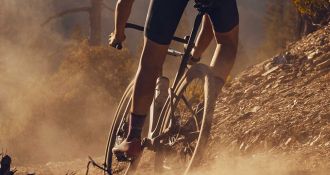
Gravel riding is the ‘in thing’ in the world of cycling and if you’ve been following our blog you will know that here at the Bicycle Chain, we love it too. We recently brought you a post on how to ride an off-road century, so we’re picking up where we left off and taking it back to basics with our top tips for gravel riding.
Bikes
Gravel bikes are defined by their ability to make mincemeat out of any off-road track, whether that be a bridleway, towpath or specific cycleway. Hydraulic disc brakes, 1x setup and dedicated geometry make gravel bikes perfect for a day out on the mucky stuff or long-distance adventures.
Electric adventure
The bike options don’t stop there. As we detailed in our previous post you can gravel ride on cyclocross and mountain bikes, but if you need that extra kick, your best bet is to go for an e-bike. Even more of an ‘in thing’ than gravel bikes themselves, the Turbo Creo SL range from Specialized marries road, gravel and turbo power to make the perfect power assisted all-rounder.
Kit
When it comes to footwear and pedals it’s best to go with the trusty SPD. Double-sided and easy to clip in and out of, SPDs are there to get you out of a spot of bother. Shoes with recessed SPDs are great because you can walk around in them without having to do the tarmac cleat dance.
Tyre choice and tyre pressure
It’s a slippery slope when talking about tyre pressures, something to really cure the insomnia. Nonetheless, when it comes to gravel riding it’s very important to get them right – you want to be running lower pressures to smooth out any bumps or crunching gravel. It’s best to go with a gravel specific tyre too because as well as being robust and slightly more puncture proof, their aggressive tread is designed specifically to stick you to the terrain.
Maintaining momentum
A key skill in gravel riding is staying at the right momentum. Hit the tracks at speed to keep the bike going forwards and to prevent any unwanted wheel slip. It’s one of a few tips which, once mastered, will make you a better bike handler across all disciplines.
Cornering
Planning and looking ahead is key when it comes to cornering on the loose stuff. Before approaching a corner you’ll want to take the weight off your back wheel slightly, choose the smoothest line on the bend and put the pedal to the floor while staying a bit more upright in order to glide round the bend. If you feel like you have over committed, sticking a foot out to counterbalance your bike should prevent you from washing out.
Vision
This is another skill that can be transferred to other disciplines. You need to be scanning the terrain ahead and then picking the smoothest line, taking care to avoid any gravel deposits or sharp objects that could cause you to puncture. Of course, you should always be keeping an eye on the road ahead, but it’s even more crucial on unpredictable terrain.
Weight distribution
Like cyclocross, positioning on the bike becomes a large factor when riding on gravel. As we have already touched on, moving about in the saddle and staying low can prevent you from having a more intimate relationship with the ground than you’d like. Staying seated when climbing is especially important to help get the maximum out of the bike and to stop your back wheel from slipping.
Braking
Hydraulic disc brakes now come as standard on gravel bikes. This is important as you need reliable and consistent braking when you’re riding off-road. Braking before the corner is a must on a gravel bike as if you brake while turning, you run the risk of taking a spill. That or master the art of drifting. You’ll look cool, we promise.
Here at the Bicycle Chain we have everything you need to start your gravel adventure. Why not come in to one of our stores to have a look at the bikes and kit you’ll need to get your gravel adventures started.